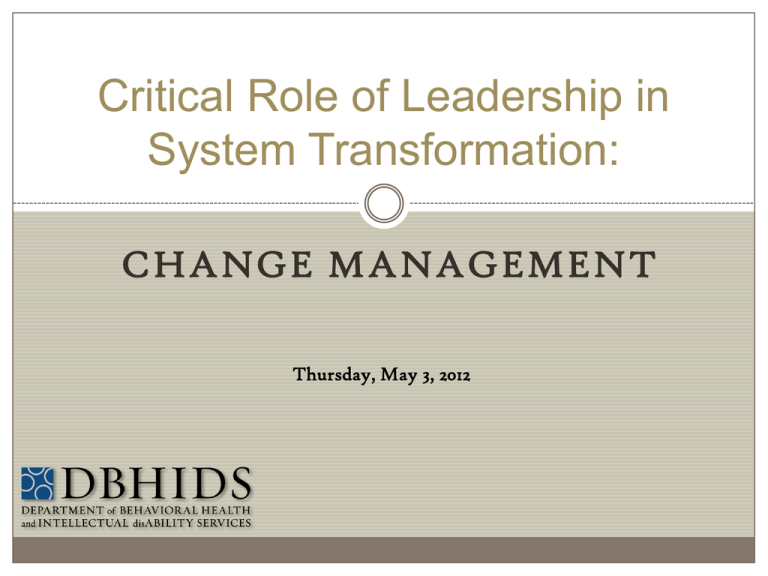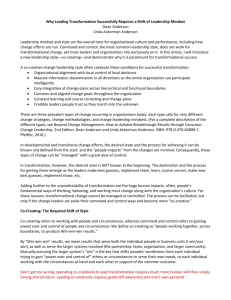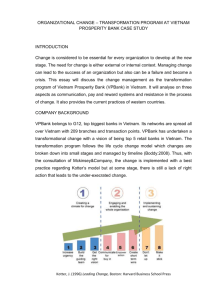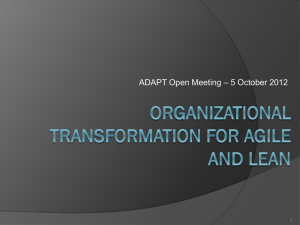Presentation Slides
advertisement

Critical Role of Leadership in System Transformation: CHANGE MANAGEMENT Thursday, May 3, 2012 Introductions & Acknowledgements Presenters: Kristen Smith Sharon Burke Wanda Sabb Learning Objectives At the end of this webinar, participants will be able to Describe the Stages of Change in System Transformation Identify the natural process people go through in dealing with change Understand the difference between Traditional and Transformational Leadership Apply The Five Practices of Exemplary Leadership to System Transformation Identify key leadership strategies for change management DBHIDS SYSTEM TRANSFORMATION MODEL The City of Philadelphia integrated its behavioral health care and intellectual disability services into a comprehensive system. The Department of Behavioral health and Intellectual disAbility Services (DBHIDS) provides services through a network of community provider agencies while collaborating with the Philadelphia School District, child welfare, judicial systems and other key stakeholders. DBHIDS staff embrace and implement a vision of: R E C O V E RY RESILIENCE S E L F - D E T E R M I N AT I O N Recovery & Resilience Oriented System of Care Recovery & Resilience Oriented System of Care Seeking to align system transformation concepts, practice and context » 10 Core Values guided the development of transformation principles and strategies, and will continue to guide the implementation process » 4 Domains in which the strategies will be carried out » 7 Goals are concrete, actionoriented goals that organize and focus the strategies www.dbhids.org » Aligning Concepts: Changing how we think » Aligning Practice: changing how we use language and practices at all levels; implementing values based change » Aligning Context: changing regulatory environment, policies and procedures, community support The Stages of System Transformation STAGES CORE STRATEGIES Pre-Contemplation Listening Exercises (focus groups with clients/families and providers) Contemplation Pro and Con Analysis of change or no change Preparation Increased availability of training and technical assistance Action Contingency management-making system rewards contingent on pro recovery, resilience and self determination practices and policies Maintenance Continued freshening of celebration and recognition ceremonies Roland Lamb, Arthur Evans, William White: The Role of Partnership in Recovery-Oriented Systems of Care: The Philadelphia Experience Change is Not Easy… It is important to understand how change affects the people in your organization. Change means letting go of something we are attached to. It triggers fear, anger, resentment and insecurity. INDIVIDUAL PROCESS OF CHANGE There are Three Phases of Dealing with Change Or How Change is Experienced: Endings Neutral Zones www.strategies-for-managing-change.com/william-bridges.html Beginnings INDIVIDUAL PROCESS OF CHANGE Endings: A period when people deal with the losses associated with change and learn more about the change. Neutral Zones: A period of ambiguity and confusion when people open up to the change and orient themselves to the new patterns of behavior. Beginnings: A period when people fully embrace the new patterns of behavior. TRANSITION TRAPEZE In the 3 phases of transition, a person can move back and forth between the stages as feelings associated with the three stages emerge. Ways of Coping with Change Say goodbye…TO THE ENDINGS Identify Benefits and Opportunities Use your support system Deal with the losses through thinking strategies Ways of Coping with Change SAY GOODBYE TO THE ENDINGS Letting people take part of their former life with them Ways of Coping with Change IDENTIFY BENEFITS AND OPPORTUNITIES What benefits and opportunities you have experienced or may experience as part of your organization’s changing dynamics? Ways of Coping with Change USE YOUR SUPPORT SYSTEM People Things Activities Your Beliefs/Attitudes Ways of Coping with Change DEAL WITH THE LOSSES THROUGH “THINKING STRATEGIES” Reframing Replacing Reinventing WHAT IS LEADERSHIP? Leadership is the ability to influence others in a manner that causes them to want to act, become, or be a part of something. www.danielgoleman.info Critical Role of Leadership There are several factors that are needed to successfully manage change: □ the ability to communicate appropriately □ effective people management □ empathy □ emotional intelligence www.kenblachard.com 20 Best Companies for Leadership BusinessWeek.com/Hay Group survey 2010 Traditional vs. Transformational Leadership Traditional Leadership Occurs when the leader rewards or punishes individuals, depending on the adequacy of performance Exchange relationship; contingent reinforcement Does not address individuals selfworth, interest or intrinsic satisfaction Transformational Leadership Provides a better fit when managing change process in System Transformation Inspire followers to commit to a shared vision for the organization, Can occur at all levels and by any individual in the organization Emphasizes intrinsic motivation and focuses on positive development of individuals in the organization Leaders create an open, trust-based culture so that communication can flow from bottom-up and top-down Traditional Leadership Transformational Leadership Leadership is responsive Leadership is proactive Works within the organizational culture Work to change the organizational culture by implementing new ideas Traditional leaders make employees achieve organizational objectives through rewards and punishment Transformational leaders motivate and empower employees to achieve company’s objectives by appealing to higher ideals and moral values Motivates followers by appealing to their own self- Motivates followers by encouraging them to interest transcend their own interests for those of the group or unit Acceptance of the status quo Broad vision- willingness to push boundaries Critique is limited and controlled (closed systems) Critique is used to identify opportunities for improvement (Open Systems) “CHANGE IS THE ONLY CONSTANT” -HERACLITUS, GREEK PHILOSOPHER Leadership Strategies for Change Management Important leadership models speak to the role of leadership in reaching to people on an emotional level to inspire the behavioral and organizational cultural changes needed for a large scale system transformation. Two highly recognized models: Eight Step Process for Leading Change 5 Practices of Exemplary Leadership 8 Step Process for Leading Change Step 1: Create Urgency Step 2: Form a Powerful Coalition Step 3: Create a Vision for Change Step 4: Communicate the Vision Step 5: Remove Obstacle Step 6: Create Short-term wins Step 7: Build on the Change Step 8: Anchor New Approaches in the Culture John Kotter: Leading Change Kotter suggests that for change to be STEP 1. CREATE URGENCY successful 75% of management needs to “buy into” the change. What can leaders do? 1. Start honest discussions 2. Identify potential threats 3. Request support To lead change, you need to bring STEP 2: FORM A POWERFUL COALITION together a coalition of influential people What can leaders do? 1. Identify the leaders in your organization 2. Ask for emotional commitment 3. Work on team building 4. Check for weak areas STEP 3: CREATE A VISION FOR CHANGE A clear vision helps everyone understand why you are asking them to do something. What can leaders do? 1. Determine values that are central to change 2. Create a strategy to execute the vision 3. Ensure change coalition can describe the vision in 5 minutes or less What you do with your vision after you create it determines your success STEP 4: COMMUNICATE THE VISION “Walk the Talk” What can leaders do? 1. Talk often about the change vision 2. Openly and honestly address concerns and anxieties 3. Apply vision to all aspects of operations 4. Lead by example Building buy-in from all levels of the organization STEP 5: REMOVE OBSTACLES Empowering people and helping the change move forward What can leaders do? 1. Identify the people resisting the change 2. Recognize and reward people for making change happen 3. Take action to quickly remove barriers Nothing motivates more than success STEP6: CREATE SHORT TERM WINS What can leaders do: 1. Create short term targets that are achievable 2. Analyze potential pros and cons of your targets 3. Reward people who help meet the targets Kotter argues that many change STEP 7: BUILD ON THE CHANGE projects fail because victory is declared too early What leaders can do? 1. After every win analyze what went right and what needs improving 2. Set goals to continue building on the momentum achieved Make any change stick, it should STEP 8: ANCHOR NEW APPROACHES IN THE CULTURE become part of the core of your organization What leaders can do? 1. Talk about progress every chance you get. 2. Tell success stories about the change process 3. Publicly recognize key members of the original change coalition 4. Create plans to replace key leaders as they move on FIVE PRACTICES OF EXEMPLARY LEADERSHIP Model the Way Inspire a Shared Vision Challenge the Process Enable Others to Act Encourage the Heart James Kouzes and Barry Posner: "The Leadership Challenge Workshop" MODEL THE WAY • Leaders’ actions speak louder than words • Stand up for beliefs • Set the example by aligning actions with shared values •Live by their values What’s it like to drive in the fog? INSPIRE A SHARED VISION □ Envision the future by imaging exciting and ennobling possibilities □ Enlist others in a common vision by appealing to shared aspirations CHALLENGE THE PROCESS ○ Challenge is the opportunity for greatness ○ Leaders welcome opportunities to test their abilities ○ Search for opportunities to change the status quo ○ Look for innovative ways to improve work and their organization ENABLE OTHERS TO ACT “The best way for me to give power to other people…is to allow creativity and freedom to explore new ideas and ways of thinking.” Jill Cleveland, Finance Manager of Apple, Inc ENABLE OTHERS TO ACT ● Leaders don’t travel alone ● Strength and develop others by sharing power and information ● Foster collaboration by promoting cooperative goals and building trust ENCOURAGE THE HEART “If everyone is doing a great job, what’s the problem in letting them know that? Lindsay Levin, Whites Group Chairman ENCOURAGE THE HEART □ Expect the best □ Personalize Recognition □ Create a spirit of community □ Be personally involved In Successful Transformations… Build a guiding team powerful enough to guide big change Guiding team develops the right vision for the change effort Create a pattern of winning Strengthen and develop others by sharing power and information Structure situations so that people can take risks Create Rewards System CONCLUSION: Leadership is the most essential element needed to lead change Successful change occurs when speaking to people’s feelings Transformational Leaders motivate and empower employees Leadership is critical to successful and lasting system transformation “The real dividing line is passion. As long as you believe what you’re doing is meaningful, you can cut through fear and exhaustion and take the next step.” Arlene Blum, PH.D in Biophysical Chemistry CRITICAL ROLE OF LEADERSHIP IN SYSTEM TRANSFORMATION THANK YOU FOR YOUR TIME AND PARTICIPATION IN THIS WEBINAR! QUESTIONS? COMMENTS?











